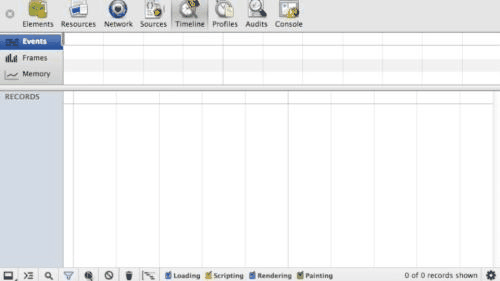While developing mobile apps with Cordova, performance is a common concern many developers have. Though recent WebView improvements have made smooth experiences easy to achieve, it is always important to watch out for code in our apps that may make the app janky.
Measuring Performance
The latest versions of Android and iOS WebViews can connect to and leverage developer tools in browsers for profiling rendering performance of apps. Developer tools provide insights into details like frames rates, repaints, layouts, etc.

Articles (like my performance audit workflow and the runtime performance checklist) articulate the typical workflow for auditing performance of webpages. Similar principles can be applied to apps too.
Automating Performance measurements
With rapid development and release cycles of apps, it becomes hard to do regular performance audits. Automating the process with tools would ensure that we have a handle on the performance of the app.
browser-perf is a NodeJS based tool picks up data from browser developer tools and converts them to key performance indicators. It is based on Chromium's performance test suite, telemetry, and supports iOS and Android based Cordova apps. All metrics are recorded while mimicking typical user interactions.
Testing iOS Apps
To start testing your Cordova app for iOS,
you would need to npm install appnium
(Appium) and set it up.
Appium is a tool to automate your app and emulate user interactions like clicking buttons or typing in the app.
Ensure that the app is built at least once and that the emulator is running.
You can then use the following NodeJS snippet to run a simple test. In the example, a value is typed entered into a text box, and a button is clicked.
var browserPerf = require('browser-perf');
browserPerf(undefined, function(err, res) {
if (err) {
console.log('An error occured');
} else {
console.log('Result is ', res);
}
}, {
selenium: "http://localhost:4723/wd/hub",
browsers: [{
platformName: "iOS",
platformVersion: "8.0",
deviceName: "iPhone Simulator",
app: "~/cordovaapp/platforms/ios/build/emulator/HelloCordova.app",
bundleId: "io.cordova.hellocordova",
autoWebview: true
}],
log: console.log.bind(console),
actions: [
function(browser) {
return browser.elementById('count').then(function(el) {
el.type(1000);
}).then(function() {
return browser.elementById('checkout');
}).then(function(el) {
return el.click();
});
}
]
});
Additional user interactions can be used instead of typing and clicking by following the guide on this page.
The video below illustrates the steps. Note that in the video, the config file does not specify any action. Hence, the default action scrolls the page and records the metrics.
Testing Android Apps
Testing Android apps is very similar to testing iOS Apps. The only difference would be the use of ChromeDriver instead of Appium. Consequently, the configuration would look something like this.
Additional details about setting up the test environment can be found
here,
with reference for browser-perf in the
axemclion wiki pages.
Finishing touches
browser-perf can record a plethora of metrics ranging from frame rates,
to count of expensive paints or expensive events that could cause jank.
Each of these metrics indicates how a CSS transform or an onscroll handler may have changed the performance of the app.
Recording this data over time can give better insight into how each code change affects the smooth experience.
The res object in browser-perf callback from the example snippet above can be saved to a database and graphed.
For example,
Perfjankie works on top of browser-perf,
stores the results in a CouchDB database, and displays the results.
Summary
In this article, we saw how to measure the rendering performance of Cordova apps. With the tools described, you can ensure that your apps are just as good as native apps are supposed to be.
If you would like to run this for your Cordova app, please contact me, and I would be glad to help you to get started or check out this related blog post.

